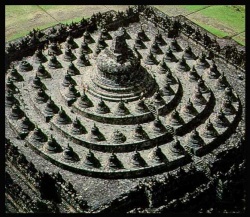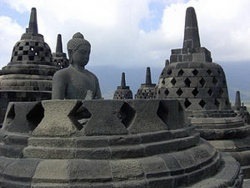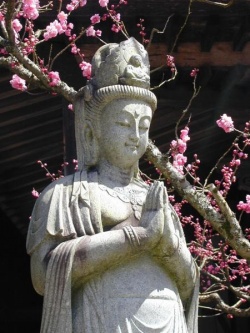Difference between revisions of "Confronting Dr. Bhattacharya’s positioning of vajrayana"
(Created page with " <poem> Dr. Bhattacharya’s inference that India knew of no deity named ekajaTA before nAgArjuna’s time is unwarranted. The colophon of ekajaTA’s sAdhana ...") |
|||
| Line 1: | Line 1: | ||
| − | + | [[File:Borobudu-21.jpg|thumb|250px|]] | |
| − | <poem> Dr. Bhattacharya’s [[inference]] that [[India]] knew of no [[deity]] named | + | <poem> |
| − | + | Dr. Bhattacharya’s [[inference]] that [[India]] knew of no [[deity]] named [[ekajata]] before [[nAgArjuna’s]] [[time]] is unwarranted. The colophon of [[ekajaTA’s]] [[sAdhana]] in [[sAdhanamAla]] is incorrectly interpreted by him to suggest this. However, the text only tries to suggest that the [[sAdhana]] was rescued or restored by [[nAgArjuna]], and not really that the [[deity]] was imported from Tibetan/Bon cultures. Besides, [[nArada purANa]] (85-123) refers to a [[deity]] named [[ekajaTA]]. There is also reference to [[ekajaTA]] in the [[guhyasamAja]], a text that was clearly [[existent]] before [[nAgArjuna]]. However, [[tArA]] in [[nAradIya purANa]] is not described with [[akShobhya]] on the {{Wiki|crown}}, or as decked with the [[mudrAs]]. These, in all possibility, were [[Buddhist]] additions to an [[existing]] [[deity]] named [[ekajaTA]] of the [[Hindu]] {{Wiki|pantheon}} during the process of [[Buddhistization]] of several popular [[Hindu]] [[deities]]. It is probably relevant to have some [[discussion]] on the claim that [[ucChiShTa gaNapati]] was a [[Buddhist]] [[deity]] originally, but some things which are close to [[heart]] are best left to remain within the deepest and most [[illuminated]] chambers of the [[hrcchakra]]. | |
| − | Dr. Bhattacharya argues that the [[Hindu]] [[tantric]] system originated from vajrayAna and bases his conclusion on the supposed “abrupt appearance” of the [[Hindu]] [[mantras]]. This would only indicate his lack of familiarity with the {{Wiki|atharva veda}}, which is described as the source of [[tantra]] by several [[tantras]] themselves. A good example would be the tAntric [[goddess]] AsurI durgA addressed as atharvaNasya duhitA and as turyavedasya putrI. A popular dhyAna [[shloka]] of bhagavatI AsurI durgA reads thus: | + | [[File:Borobudur-14o.jpg|thumb|250px|]] |
| − | + | Dr. [[Bhattacharya]] argues that the [[Hindu]] [[tantric]] system originated from [[vajrayAna]] and bases his conclusion on the supposed “abrupt appearance” of the [[Hindu]] [[mantras]]. This would only indicate his lack of familiarity with the {{Wiki|atharva veda}}, which is described as the source of [[tantra]] by several [[tantras]] themselves. A good example would be the [[tAntric]] [[goddess]] [[AsurI durgA]] addressed as [[atharvaNasya duhitA]] and as [[turyavedasya putrI]]. A popular [[dhyAna]] [[shloka]] of [[bhagavatI]] [[AsurI durgA]] reads thus: | |
| + | [[File:Daienin Kannon.JPG|thumb|250px|]] | ||
bAlendushvetavarNAM vikasitanayanAM vAmahasta-trishUlAM | bAlendushvetavarNAM vikasitanayanAM vAmahasta-trishUlAM | ||
dakShe sthAlya~NkushADhyAM hR^idaruNavadanAM nAgayaj~nopavItAm | | dakShe sthAlya~NkushADhyAM hR^idaruNavadanAM nAgayaj~nopavItAm | | ||
| Line 9: | Line 10: | ||
durgAM padmAsanasthAmakhilavashakarImAsurIM bhAvayAmi || | durgAM padmAsanasthAmakhilavashakarImAsurIM bhAvayAmi || | ||
| − | For those that require a third-party proof, a noted shAkta lists the pramANa of {{Wiki|jaina}} authors sIlankAchArya and sanghadAsa, both placed prior to 6th century AD. In their works (sUtrakrtAnga and vAsudeva charita), they refer to the [[mantra]] niyogas of the atharvaNa [[veda]] as also the various abhicharic [[rites]] that originate from this [[veda]]. Arthur Avalaon, in an appendix to [[Shakti]] and {{Wiki|Shakta}}, discusses the AtharvaNic origin of [[tantra]] with reasonable clarity. | + | For those that require a third-party proof, a noted [[shAkta]] lists the [[pramANa]] of {{Wiki|jaina}} authors [[sIlankAchArya]] and [[sanghadAsa]], both placed prior to 6th century AD. In their works ([[sUtrakrtAnga]] and [[vAsudeva]] [[charita]]), they refer to the [[mantra]] [[niyogas]] of the [[atharvaNa]] [[veda]] as also the various [[abhicharic]] [[rites]] that originate from this [[veda]]. Arthur Avalaon, in an appendix to [[Shakti]] and {{Wiki|Shakta}}, discusses the [[AtharvaNic]] origin of [[tantra]] with reasonable clarity. |
| − | As for mahAvidyA-s, there is repeated [[discussion]] of the derivation of the ten [[cosmic]] [[powers]] from trishakti in various [[scriptures]], oft neglected by those who notice only the [[shiva]] purANa reference. vAk (vANI), kAlikA and tArA are described as [[emanations]] of sarasvatI; bAlA, tripurA, annapUrNA and bagalAmukhI of mahAlakShmI; ChinnamastA, bhairavI, matanginI and dhUmAvatI of durgA. Thus, the origin of mahAvidyA-s is traced to the three [[primary]] [[shaktis]] brAhmI, vaiShNavI and raudrI (somewhat crudely) – and assigning [[Buddhistic]] origins to the mahAvidyAs including tArA is probably a grave and popular mistake. | + | As for mahAvidyA-s, there is repeated [[discussion]] of the derivation of the ten [[cosmic]] [[powers]] from trishakti in various [[scriptures]], oft neglected by those who notice only the [[shiva]] [[purANa]] reference. [[vAk]] ([[vANI]]), [[kAlikA]] and [[tArA]] are described as [[emanations]] of [[sarasvatI]]; bAlA, [[tripurA]], [[annapUrNA]] and [[bagalAmukhI]] of [[mahAlakShmI]]; [[ChinnamastA]], [[bhairavI]], [[matanginI]] and [[dhUmAvatI]] of [[durgA]]. Thus, the origin of [[mahAvidyA]]-s is traced to the three [[primary]] [[shaktis]] [[brAhmI]], [[vaiShNavI]] and [[raudrI]] (somewhat crudely) – and assigning [[Buddhistic]] origins to the [[mahAvidyAs]] including [[tArA]] is probably a grave and popular mistake. |
| − | Another text to closely study would be the manjushrImUlakalpa. majushrI, described as [[kumara]] and as kArtikeya (if that itself is not a giveaway), is the topic of this work which specifically refers to [[shaiva]], vaiShNava, gAruDa and other categories of [[mantras]] related to viShNu, [[shiva]], [[brahma]], [[Aditya]], garuDa, mahAlakShmI etc. There is also mention of the “[[laukika]]” [[mantras]] which are clearly segregated from the [[Buddhist]] [[mantras]]. This clearly indicates the presence of a well-developed system of [[tantra]] much before the [[emergence]] of vajrayAna. One should also pay careful [[attention]] of several vajrayAnic [[mantra]] [[siddhas]] – droNa, ashvatthAmA, {{Wiki|arjuna}} etc. who are simply popular [[Hindu]] personages accommodated into Buddhisitc [[mantric]] lore. They also include in this list R^iShabhadeva, nAbhi, bharata and other {{Wiki|jaina}} personages. | + | Another text to closely study would be the [[manjushrImUlakalpa]]. [[majushrI]], described as [[kumara]] and as [[kArtikeya]] (if that itself is not a giveaway), is the topic of this work which specifically refers to [[shaiva]], vaiShNava, gAruDa and other categories of [[mantras]] related to viShNu, [[shiva]], [[brahma]], [[Aditya]], garuDa, mahAlakShmI etc. There is also mention of the “[[laukika]]” [[mantras]] which are clearly segregated from the [[Buddhist]] [[mantras]]. This clearly indicates the presence of a well-developed system of [[tantra]] much before the [[emergence]] of vajrayAna. One should also pay careful [[attention]] of several vajrayAnic [[mantra]] [[siddhas]] – droNa, ashvatthAmA, {{Wiki|arjuna}} etc. who are simply popular [[Hindu]] personages accommodated into Buddhisitc [[mantric]] lore. They also include in this list R^iShabhadeva, nAbhi, bharata and other {{Wiki|jaina}} personages. |
| − | Dr. Bhattacharya also [[observes]] that prefix [[vajra]] to the [[name]] of a [[deity]] is a sign of his/her origin from vajrayAna. He fails to consider the sixteen {{Wiki|jaina}} vidyA-devIs including vajrashrinkhalA, vajrAnkushI etc., listed in nirvANakalikA by pAdaliptasUrin much before the [[emergence]] of vajrayAna. | + | Dr. [[Bhattacharya]] also [[observes]] that prefix [[vajra]] to the [[name]] of a [[deity]] is a sign of his/her origin from [[vajrayAna]]. He fails to consider the sixteen {{Wiki|jaina}} [[vidyA-devIs]] including [[vajrashrinkhalA]], [[vajrAnkushI]] etc., listed in [[nirvANakalikA]] by [[pAdaliptasUrin]] much before the [[emergence]] of [[vajrayAna]]. |
| − | The give and take between the [[Hindu]] [[tantra]] and vajrayAna is effectively summarized by Arthur Avalon in his introduction to Chakrasambhara thus: | + | The give and take between the [[Hindu]] [[tantra]] and [[vajrayAna]] is effectively summarized by Arthur Avalon in his introduction to [[Chakrasambhara]] thus: |
“With each fresh acquirement of [[knowledge]] as to [[Buddhism]], it seems more difficult to separate it from the [[Hinduism]] out of which it emerged, and into which it relapsed”. | “With each fresh acquirement of [[knowledge]] as to [[Buddhism]], it seems more difficult to separate it from the [[Hinduism]] out of which it emerged, and into which it relapsed”. | ||
| − | There however seems to be some validity to his position on the panchatattva of the kaulas which needs to be examined in [[greater]] detail. I wonder sometimes as to what could have influenced Dr. Bhattacharya's line of [[thinking]] considering the school of [[thought]] of his own father mahAmahopAdhyAya [[Haraprasad Shastri]]. | + | There however seems to be some validity to his position on the [[panchatattva]] of the kaulas which needs to be examined in [[greater]] detail. I wonder sometimes as to what could have influenced Dr. Bhattacharya's line of [[thinking]] considering the school of [[thought]] of his own father [[mahAmahopAdhyAya]] [[Haraprasad Shastri]]. |
</poem> | </poem> | ||
{{R}} | {{R}} | ||
Revision as of 13:14, 21 September 2013
Dr. Bhattacharya’s inference that India knew of no deity named ekajata before nAgArjuna’s time is unwarranted. The colophon of ekajaTA’s sAdhana in sAdhanamAla is incorrectly interpreted by him to suggest this. However, the text only tries to suggest that the sAdhana was rescued or restored by nAgArjuna, and not really that the deity was imported from Tibetan/Bon cultures. Besides, nArada purANa (85-123) refers to a deity named ekajaTA. There is also reference to ekajaTA in the guhyasamAja, a text that was clearly existent before nAgArjuna. However, tArA in nAradIya purANa is not described with akShobhya on the crown, or as decked with the mudrAs. These, in all possibility, were Buddhist additions to an existing deity named ekajaTA of the Hindu pantheon during the process of Buddhistization of several popular Hindu deities. It is probably relevant to have some discussion on the claim that ucChiShTa gaNapati was a Buddhist deity originally, but some things which are close to heart are best left to remain within the deepest and most illuminated chambers of the hrcchakra.
Dr. Bhattacharya argues that the Hindu tantric system originated from vajrayAna and bases his conclusion on the supposed “abrupt appearance” of the Hindu mantras. This would only indicate his lack of familiarity with the atharva veda, which is described as the source of tantra by several tantras themselves. A good example would be the tAntric goddess AsurI durgA addressed as atharvaNasya duhitA and as turyavedasya putrI. A popular dhyAna shloka of bhagavatI AsurI durgA reads thus:
bAlendushvetavarNAM vikasitanayanAM vAmahasta-trishUlAM
dakShe sthAlya~NkushADhyAM hR^idaruNavadanAM nAgayaj~nopavItAm |
nAnAla~NkArayuktAM sulalitavadanAM turyavedasya putrIM
durgAM padmAsanasthAmakhilavashakarImAsurIM bhAvayAmi ||
For those that require a third-party proof, a noted shAkta lists the pramANa of jaina authors sIlankAchArya and sanghadAsa, both placed prior to 6th century AD. In their works (sUtrakrtAnga and vAsudeva charita), they refer to the mantra niyogas of the atharvaNa veda as also the various abhicharic rites that originate from this veda. Arthur Avalaon, in an appendix to Shakti and Shakta, discusses the AtharvaNic origin of tantra with reasonable clarity.
As for mahAvidyA-s, there is repeated discussion of the derivation of the ten cosmic powers from trishakti in various scriptures, oft neglected by those who notice only the shiva purANa reference. vAk (vANI), kAlikA and tArA are described as emanations of sarasvatI; bAlA, tripurA, annapUrNA and bagalAmukhI of mahAlakShmI; ChinnamastA, bhairavI, matanginI and dhUmAvatI of durgA. Thus, the origin of mahAvidyA-s is traced to the three primary shaktis brAhmI, vaiShNavI and raudrI (somewhat crudely) – and assigning Buddhistic origins to the mahAvidyAs including tArA is probably a grave and popular mistake.
Another text to closely study would be the manjushrImUlakalpa. majushrI, described as kumara and as kArtikeya (if that itself is not a giveaway), is the topic of this work which specifically refers to shaiva, vaiShNava, gAruDa and other categories of mantras related to viShNu, shiva, brahma, Aditya, garuDa, mahAlakShmI etc. There is also mention of the “laukika” mantras which are clearly segregated from the Buddhist mantras. This clearly indicates the presence of a well-developed system of tantra much before the emergence of vajrayAna. One should also pay careful attention of several vajrayAnic mantra siddhas – droNa, ashvatthAmA, arjuna etc. who are simply popular Hindu personages accommodated into Buddhisitc mantric lore. They also include in this list R^iShabhadeva, nAbhi, bharata and other jaina personages.
Dr. Bhattacharya also observes that prefix vajra to the name of a deity is a sign of his/her origin from vajrayAna. He fails to consider the sixteen jaina vidyA-devIs including vajrashrinkhalA, vajrAnkushI etc., listed in nirvANakalikA by pAdaliptasUrin much before the emergence of vajrayAna.
The give and take between the Hindu tantra and vajrayAna is effectively summarized by Arthur Avalon in his introduction to Chakrasambhara thus:
“With each fresh acquirement of knowledge as to Buddhism, it seems more difficult to separate it from the Hinduism out of which it emerged, and into which it relapsed”.
There however seems to be some validity to his position on the panchatattva of the kaulas which needs to be examined in greater detail. I wonder sometimes as to what could have influenced Dr. Bhattacharya's line of thinking considering the school of thought of his own father mahAmahopAdhyAya Haraprasad Shastri.


